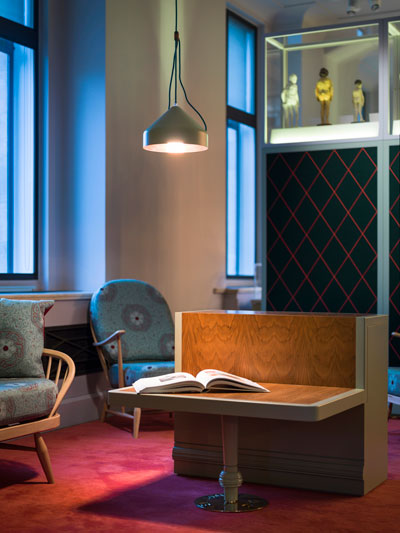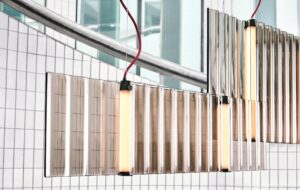|
Opening later on 5 February, the London institution’s wondrous new library by architecture and design practice AOC combines the spirit of open access with the aesthetic of open-heart surgery The Wellcome Collection, which bills itself as a destination for the “incurably curious”, has transformed a double-height space on the second floor into a new public area. The room – with its frieze emblazoned with the names of famous scientists (Pavlov, Pinel, Paracelsus, Darwin) – used to be a white gallery space decorated with ancient sculptures of pagan gods known as the Hall of Statuary. It then became a library, cluttered and closed off with book stacks. In its new design, part gallery and part library, London practice AOC echoes both aspects of the room’s past. “They wanted it busy, but not chaotic,” says AOC director Geoff Shearcroft of the brief, “with the physical presence of a church, but the interactivity of social media.” The 390sq m hall, which will be reached by the spiral staircase that architect Wilkinson Eyre is building as part of the Wellcome’s current £17.5 million redevelopment, is both reading room and cabinet of curiosities, where 100 artefacts – medical oddities once relegated to storage at an old post office building in Earls Court – are now on view. Henry Wellcome, who collected this treasure trove, wanted to create a museum of man, a version of Oxford’s Pitt Rivers Museum that would not only show how material culture had evolved over time, but would also trace man’s perennial battle with disease, from the shaman’s rattle to aspirin.
All the bookcases are painted the same green as a doctor’s scrubs The room has windows on three sides and, on the remaining wall, under a mezzanine that shields the area from natural light, there are paintings – some gruesome – of blood lettings, teeth pulling and the suturing of wounds. Displayed on plinths in the centre of the room are an antique X-ray machine and a dentist’s station, both of which resemble torture devices, as well as a folkloric collection of London amulets and one of Gunther von Hagens’s plastinated slices through a human corpse. These are shown alongside works by contemporary artists and designers including Marc Quinn, Helen Storey and Eleanor Crook. The book stacks on the other side of the room are generously spaced, with glass cabinets on top showcasing more curios. Each stack is devoted to a different theme – the Body, Face, Pain, Breath – while their lower levels house drawers incorporating the distinctive silhouette of the walrus-moustached Wellcome.
Each reading table is set at two heights, with two round metal bases that resemble a pill, the invention that made Wellcome his fortune These contain archive boxes filled with reproductions of precious materials from the collection, such as medieval manuscripts and 1930s public-health posters, which visitors may peruse with archival gloves. Objects such as straitjackets and stethoscopes are available to be tried on or used – Shearcroft tells me that the “most selfied spot” is a reconstruction of Freud’s couch. Visitors can also leave cuttings on pinboards, and write comments on bookmarks in the thousand or so volumes on open access. The plinths and bookcases are decorated in the medical green of a doctor’s scrubs. The Vitra furniture is all oak, but composed of odd sets. Each reading table is set at two heights, with two round metal bases that resemble a pill, the invention that made Wellcome his fortune. (His cocaine pills, labelled “Forced March”, were “to be dissolved in the mouth every hour when undergoing continued mental strain or physical exertion”: the Wellcome Trust is now the third richest charity in the world.) Ercol sofas and chairs are arranged on a blood-red carpet, under chandeliers made by Dutch design studio Vij5 that Shearcroft says offer “a hint of a mosque”. The sofas are decorated in a material depicting the crystallography of insulin, a design originally used as wallpaper during the Festival of Britain, while cushions decorated in the same fabric frame a similarly ruby staircase. This has been blocked off and is intended to serve as auditorium seating for events, presided over by death masks of Beethoven and Wellcome himself. |
Words Christopher Turner
Images: Ben Gilbert / Wellcome Trust |
|
|


















